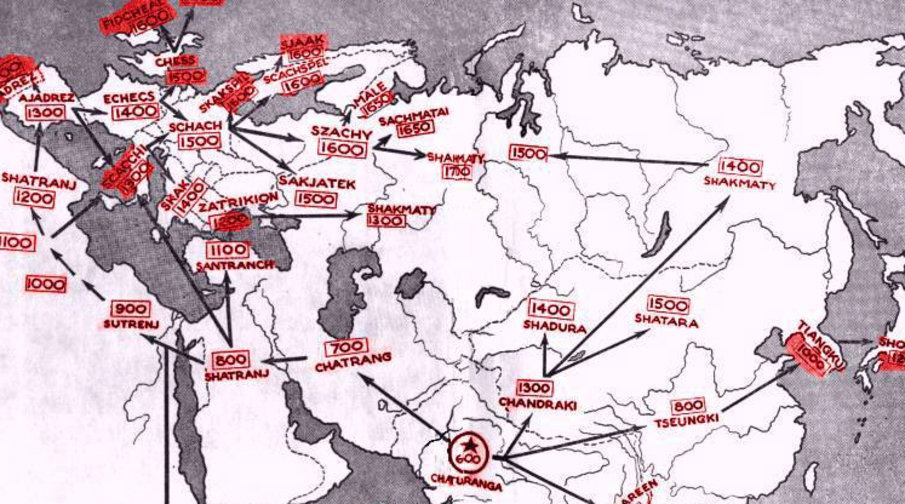
England is the home of football, and baseball is a quintessentially American sport. But no nation can claim chess as its own. It is a truly global game. Yet as this map shows, it too has a history, and a geography.
The origins of chess can be traced all the way back to 6th-century India. From there it spread around the world, mutating along the way.
But its journey was considerably slower than the viral memes of our connected age, which shoot across the globe in mere minutes. It took chaturanga a thousand years to reach Iceland as skak.This map, taken from the endpapers of A Short History of Chess (1949) by Henry Alexander Davidson, shows the routes both to the east and west travelled by the game, the approximate dates when it reached various parts of the world, and the local names for the game.
The game is first attested as chaturanga in India, around 600 AD. Chaturanga is Sanskrit for “four-limbed”, a reference to the four divisions of the Indian army (as also mentioned in the epic Mahabharata): infantry, cavalry, elephantry and chariotry. Pieces denoting those four divisions are the respective precursors of the pawns, knights, bishops and rooks of the modern game.
Chaturanga had two features still in evidence in modern chess: pieces having different powers, and victory being dependent on one piece (i.e. the king in the modern game). It did not appear out of nowhere; there is archaeological evidence of similar board games from the Indus Valley Civilisation (2600–1500 BCE).
The game’s first excursion outside India is to Persia (700 AD, chatrang), where it became part of the courtly education. Persian players exclaimed “shāh māt!
” (“the king is helpless”) when they had cornered their opponent’s main piece – the origin of the term ‘checkmate’.The Arab scholar al-Masudi reports that chess was introduced into Persia under the reign of Sassanid emperor Chosroës I, also known as Nushirwan (r. 531 to 579), more than a century earlier than mentioned on this map.

After the Muslim conquest of Persia, the game – and the Persian exclamation of victory – travels to Arabia (800 AD, shatranj), and eventually further west, with the expanding Islamic empire to Egypt (900 AD, sutrenj).
The earliest recorded game of chess dates to 10th-century Baghdad, and is between a historian Abu-Bakr Muhammed Ben Yahya as-Suli and his pupil Abu’l- Faraj bin al-Muzaffar bin Sa’-id al-Lajlaj.
Back then, the queen could only move a square diagonally a time, the bishops moved diagonally skipping a square, and pawns could only move a square a time and could only be promoted to queen. Castling was unknown, and you could win by checkmate and stalemate. As-Suli played white, and won.
From the crossroads of Africa, Europe and Asia, the march of chess branches off to the south, towards Ethiopia (1000 AD, shatranj); to the west, through North Africa to the Maghreb (1200 AD, shatranj); and to the north, through Asia Minor (1100 AD, santranch) to Constantinople (1200 AD, zatrikion). Muslim invaders also imported the name, and the game to Spain (1300 AD, ajedrez) and Portugal (1400 AD, xadrez).
In India, the chess pieces had been ornate and lifelike. The Islamic interdiction on depicting living creatures – a rule meant to prevent idolatry, and enforced most strictly against depictions of the prophet Muhammad – led to the chess pieces becoming more abstract and nonrepresentational.
In Christian Europe, human and animal shapes reappeared, reinterpreted by and for the age:…
The post India to Iceland in a Mere Millennium: How Chess Went Global appeared first on FeedBox.